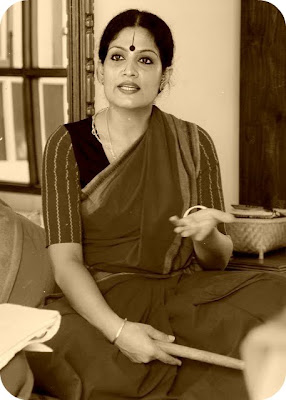by Padamashri Geeta Chandran

When we have amazing techniques perfected over centuries that cement cultural identities, it seems a real shame that our formal education system eschews this as unimportant. I have no problem in giving up what is old if what replaces it is superior to what is being replaced.The 0-8 age group is very crucial to dance teachers and other creative education mentors. This is the age that we begin our arduous journey into the dance. We are taught to observe, imitate, think, correct, practice, absorb, feel…the list is endless. The ambience of the class, the nature of the peer group, the personality of the Guru, the teaching process are all so unique and so very different from other forms of learning that it generates a different set of sensibilities in the students.
Through the past 20 years that I have taught Bharatanatyam, I have closely monitored this process. To me the challenge is to make the learning of dance an exciting and engaging journey for today’s child.
The early years are invaluable for imprinting the senses with textures of “Indian-ness”. Unfortunately, this process is not engaged with the seriousness it demands. The majority of our urban children are fed creative products that do not imprint them with any distinct sense of our culture. These products work on least common denominators of entertainment and the values they promote are rather suspect. See how many of our city children play with violent toys (including WWF macho fighters) and play electronic games where destroying the enemy becomes the key objective. Such engagements do not permit the development of any moral compass in the child. And to me the development of bedrock values should become the key inputs of guidance of children in the 0-8 age group.
Of course children imbibe what they are taught. A favourite quote of mine can be paraphrased as: One preserves/cherishes what one loves, and one loves, what one knows, and one knows what one is taught! So the key is to get the teaching right. Music, dance and drama must become key components of teaching this age-group.
Let me take this opportunity to share what I have personally gained from the classical dance which I began learning from the young age of 5 from giant gurus.
Aesthetics: Whatever one does, the same sense of aesthetics needs to be visible. On stage, off stage, in one’s lifestyle, in one’s eye for detail and beauty, all need to be linked. Dance does help me to be sensitive to beauty. My teachers gave me that Vidya. Right from the colours one adorns, to the certainty as to what looks good on the individual and style in terms of how one holds oneself in public and private. Everything is in aesthetic continuum.
Rid of inhibitions: Not only does the dance teach you to use the body in a very very creative way and makes you completely at ease with the instrument, you also learn to express emotions of various kinds in a completely natural and uninhibited manner. This is particularly relevant to GenNext who spend inordinate amounts of time in their e-world and lose out on interpersonal skills which encourage expressing themselves.
Sharing: This is an unconventional spin-off of learning classical dance. When dance is taught to a small group, the creative journey is a shared experience for every participant. If a jati (pure dance sequence) is taught, then how each dancer first perceives it, then how they collectively unravel the nuances of the rhythm and they again how they individually strive to reach that centum of perfection through unending repetition…This is truly a unique and exciting process, and the combined learning experience of the group is extremely valuable.
Group dynamics: As the dance moves from a solo art form to a more group-oriented experience. I feel that a group of dancers is not all about technique alone but display kinetics of a well-knit organic identity. They need to be emotionally connected, trust each other implicitly and also display the commonness of their learning and choreographic experience. A group of dancers is a dictionary of their bonding in the process.
Concentration: Today’s child has a narrower attention span – geared to a commercial break after every ten minutes or so. Developing concentration is a huge challenge for teachers. In dance we struggle to be able to keep to a given beat, create counter patterns and still return to the sama in the same meter. That requires undivided concentration and sadhna.
 Balance: The basic posture of Bharatanatyam is a prime example of holding the body in balance and in perfect equilibrium. What is done for the right side is repeated symmetrically for the left with equal perfection. All this teaches invaluable lessons in balance. Also, the balance between movement and silence is a wonderful by product of the dance process.
Balance: The basic posture of Bharatanatyam is a prime example of holding the body in balance and in perfect equilibrium. What is done for the right side is repeated symmetrically for the left with equal perfection. All this teaches invaluable lessons in balance. Also, the balance between movement and silence is a wonderful by product of the dance process.Breath control: With experience one is able to connect the breath to the pattern of the movement. Every movement is architecture around the flow of human breath. So recognizing the power of breath gives us better control of our bodies.
Endurance: Through a very scientific teaching methodology, the dancer is taught to build stamina to sustain a performance that can span up to 3 hours duration.
Posture: Then spine is the real student. How one moulds the spine and how the posture is corrected is the basis for the dance
Veneration: The dancer learns to respect tradition. It is a humbling experience if taught and learnt in the right spirit.
Sequencing: As the student learns the basics and moves on, one of the most important lessons the dance unknowingly imparts is the strength of sequencing. Of proceeding in life step by step. Of gaining the insight that one can stretch both of one’s legs only when one is seated properly. If both legs are stretched while standing, one can only fall badly and hurt oneself! So achievement is broken into fixed sequences.
Learning of mythology: Dance boldly steps in to fill this void which is one of the casualties of formal education. Dance, based on mythology and narratives, makes the learners familiar with these narratives. To be rooted one has to be familiar with mythology. It gives a stroing value base and provides us metaphors for life!
These are some of the tangibles that the dance has given me. And then there are the wonderful intangibles too: the ability to reach the innermost recesses of my soul -- what I call Point Zero -- is one of the greatest blessings the dance gives me.
When we have amazing techniques perfected over centuries that cement cultural identities, it seems a real shame that our formal education system eschews this as unimportant. I have no problem in giving up what is old if what replaces it is superior to what is being replaced.
Can we truly say today that the systems we have embraced can offer similar joy?
The jury is still out on that question.
Geeta Chandran, Classical Dancer/Choreographer and Founder-President Natya Vriksha


No comments:
Post a Comment